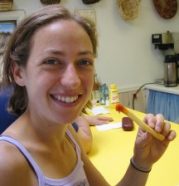News Detective: Emily investigates french fries
Share this:
- Share via email (Opens in new window) Email
- Click to share on Facebook (Opens in new window) Facebook
- Click to share on X (Opens in new window) X
- Click to share on Pinterest (Opens in new window) Pinterest
- Click to share on Reddit (Opens in new window) Reddit
- Share to Google Classroom (Opens in new window) Google Classroom
- Click to print (Opens in new window) Print
 |
| Emily savors a french fry. |
I first found the french-fry scientists when I was in graduate school in Santa Cruz, California, in 2000. My assignment was to write a feature story about something science-related. It would be my first long story, and I wanted to find a topic that involved lots of science but that would be interesting to everyone, even people who think they don’t like science.
After an extensive and increasingly frantic search as my deadline approached, I came across a Web site for the food science department at the University of California in Davis. Research topics ranged from “the role of dietary fat in tissue function” to “interactions of microorganisms in foods.” Boring, boring. Then, I came across Professor Paul Singh’s home page and descriptions of his research into fried foods. Bingo!
For me, the topic was especially dear. “French fry” was actually my first word. As a very young child, I pronounced it “fry fry” by mistake, but I loved the crispy, salt-drenched things, and I still do. Pretty soon, my feature found a focus: The scientific search for fried-potato perfection.
To report the story, I made the 2-hour drive from Santa Cruz to Davis one weekend in March. It just so happened I had a terrible flu and fever at the time, but I still managed to visit Singh’s lab to meet with him and his colleagues. Even as I constantly blew my nose and coughed up my lungs, the researchers showed me their equipment, which included industrial fryers, thermometers, and a sophisticated poking machine called the Texture Analyzer, which looks like an overgrown 3-D Hangman board, and measures the crispiness of fried potato patties. Here’s an excerpt from the original story:
“The experiments require three people to make sure every patty gets measured the same way. Because texture changes with temperature and time after frying, the scientists run from fryer to Texture Analyzer, with stopwatches, thermometers, and cutting knives in hand. They wear special gloves and safety glasses to avoid the splatter of hot frying oil. They measure crust resilience, and they conduct ‘stress relaxation tests,’ which rate potato patties for their ability to bounce back after compression. They test each crust 15 times.”
I also spent a few hours at a local McDonald’s restaurant, just watching batches of fries go into the fryer again and again. I timed how long the fries stayed in the oil, and I took notes on temperature and other details. I got a lot of funny looks and comments from customers. Many of them wanted to know if I was an official french fry inspector!
To really round out my research, I thought it was important to do some of my own sampling. So, for a few weeks while I was working on the story, I ate as many french fries as I could. I tried them at every restaurant around town, and I asked waiters and waitresses lots of questions about what kind of potatoes they used and how they were cooked. Funny enough, I never got sick of them. In fact, for me, knowing where french fries come from makes the eating experience even richer!